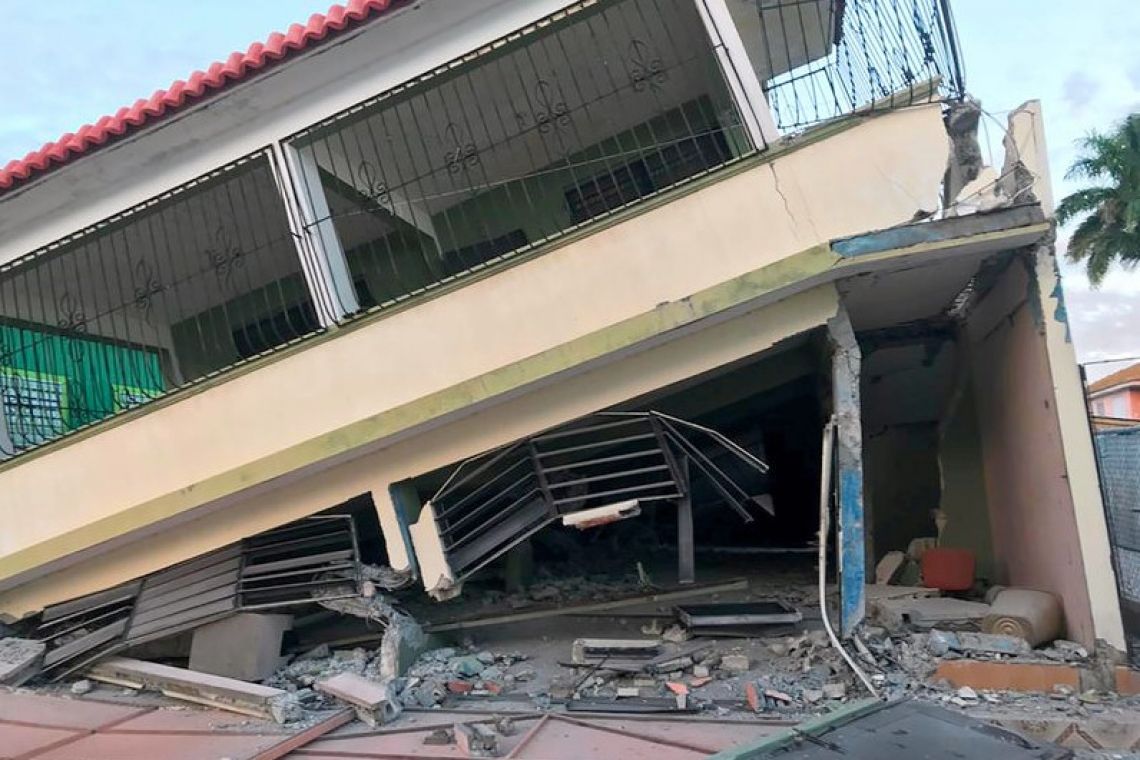A home is seen collapsed after an earthquake in Guanica, Puerto Rico, January 7, 2020. Photo credit Reuters/Ricardo Ortiz.
SAN JUAN, Puerto Rico--Puerto Rico Governor Wanda Vazquez declared a state of emergency and activated the National Guard on Tuesday after a series of earthquakes including one of magnitude 6.4 that was the most powerful to strike the Caribbean island in 102 years.
The quakes killed at least one person, provoked a protective power outage across the entire island and cut off drinking water to 300,000 customers, Vazquez told a news conference.
At least 346 people were left homeless, officials said, as homes were flattened, mostly in the south of the island. Many damaged buildings sat next to piles of rubble.
The declaration of emergency will facilitate federal financial aid for the US territory. Vazquez said she had been in contact with the Federal Emergency Management Agency (FEMA). Several members of Congress including Florida’s two US senators and Puerto Rico’s non-voting member of the House of Representatives appealed to US President Donald Trump for aid.
Trump has been briefed on the earthquakes and administration officials were monitoring the impact in coordination with Puerto Rico officials, White House Deputy Press Secretary Judd Deere said in a statement.
The island has been rocked by a series of quakes – literally hundreds – since December 28, including 10 of magnitude 4 or greater, the US Geological Survey said. A 5.8-magnitude quake on Monday damaged some homes on the southern coast.
Powerful quakes are rare in Puerto Rico, and Tuesday’s 6.4 was the strongest in more than a century, the island’s seismology office Red Sismica said. On October 11, 1918, a 7.3 magnitude quake and tsunami killed 116 people, according to Red Sismica data.
The US territory is still recovering from a pair of devastating 2017 hurricanes that killed about 3,000 people and destroyed a significant amount of infrastructure. Puerto Rico is also working through a bankruptcy process to restructure about US $120 billion of debt and pension obligations.
“We are a resilient people. We have responded to many difficult situations. Now this has been asked of us one more time,” said Vazquez, who later toured damaged areas.
One of Tuesday’s quakes triggered an automatic shutdown of electricity across the island as a safety measure and a later, more powerful quake damaged power plants in the southern part of the island, Vazquez said.
Power remained cut off to the capital San Juan and most of the island some 11 hours after the largest quake.
Puerto Rico was producing only 40 megawatts of electricity when demand was close to 2,000 megawatts, Angel Figueroa, president of the electricity workers’ union UTIER, said on Twitter.
Some 300,000 of Puerto Rico’s 1.3 million water customers lacked service, Vazquez said. The governor confirmed one death, as reported by El Nuevo Dia, that a 73-year-old man died after a wall fell on him.
But she said it was too soon to offer an accurate assessment of damage or injuries.
Vazquez, who assumed office in August after Ricardo Rossello stepped down in the face of massive street protests, repeated pleas for people to remain calm and asked people to check on neighbours, especially the elderly.
The biggest quake on Tuesday, of magnitude 6.4, struck at a depth of 10 kilometres (six miles) at 4:24am (0824 GMT) near Ponce on the island’s southern coast, the US Geological Survey said.
Witnesses on social media described it as “super strong” and lasting up to 30 seconds. It was followed by a number of hefty aftershocks including two measuring 5.6.
The international airport near San Juan continued normal service with the help of power generators, El Nuevo Dia reported, citing Jorge Hernandez, chief executive of Aerostar Airport Holdings. ~ Reuters ~







